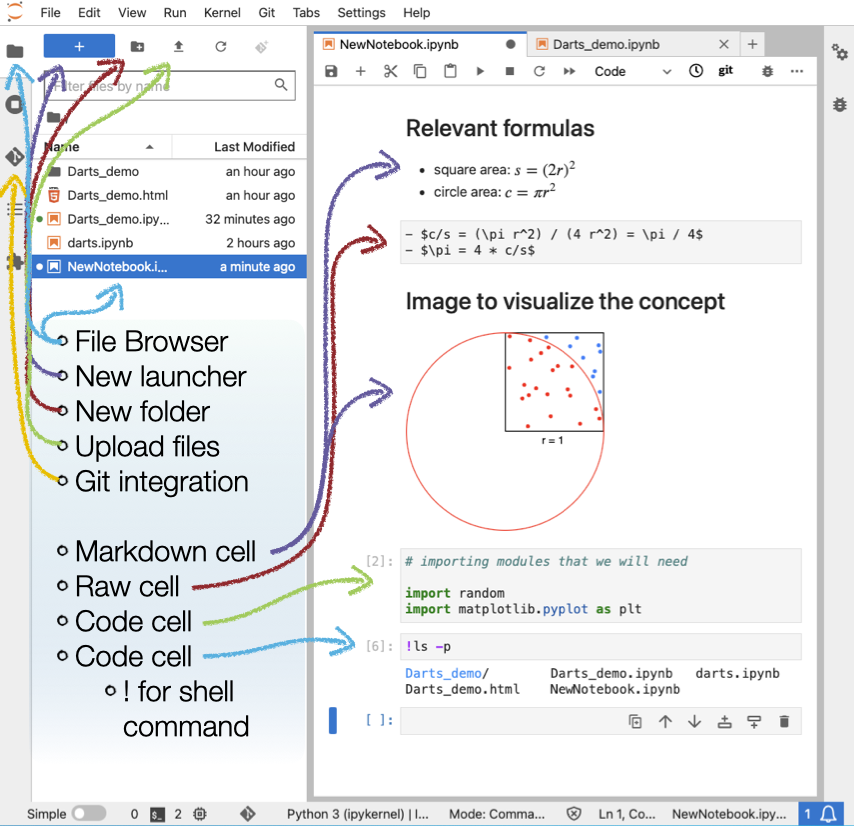JupyterLab and notebook interface
Objectives
Learn to navigate JupyterLab user interface.
Discuss integrated development environments.
Get an overview of useful keyboard shortcuts.
Learn about command/edit modes and markdown/code cells.
Instructor note
15 min teaching
0 min exercises
JupyterLab is the next-generation user interface for Jupyter Notebooks and is intended to replace the conventional interface. It is a highly modular and customizable interface.
How to start JupyterLab
Let’s have a look at how it works. We go to terminal, and type:
$ mkdir jupyterlab-demo
$ cd jupyterlab-demo
$ jupyter-lab
Components: the big picture

Components of a Jupyter notebook.
Cells
Markdown cells contain formatted text written in Markdown
Code cells contain code to be interpreted by the kernel (Python, R, Julia, Octave/Matlab…)
Markdown cells
## Second level heading
This cell contains simple
[markdown](https://daringfireball.net/projects/markdown/syntax), a simple language for writing text that can be automatically converted to other formats, e.g. HTML, LaTeX or any of a number of others.
**Bold**, *italics*, **_combined_**, ~~strikethrough~~, `inline code`.
* bullet points
or
1. numbered
3. lists
**Equations:**
inline $e^{i\pi} + 1 = 0$
or on new line
$$e^{i\pi} + 1 = 0$$
Images:

Links:
[One of many markdown cheat-sheets](https://github.com/adam-p/markdown-here/wiki/Markdown-Cheatsheet#emphasis)
Code cells
# a code cell can run statements of code.
# when you run this cell, the output is sent
# from the web page to a back-end process, run
# and the results are displayed to you
print("hello world")
Command and edit modes
To add contents to a cell, you need to enter edit mode by pressing
Enteror double-clicking on a cellTo navigate between cells, create new cells, etc., you need to enter command mode by pressing
Escapekey or executing the current cell.
Keyboard shortcuts
Some shortcuts only work in Command or Edit mode. It can also happen that these shortcuts interfere with browser shortcuts.
Cell shortcuts
Shortcut |
Effect |
|---|---|
|
Enter Edit mode |
|
Enter Command mode |
|
Run the cell |
|
Run the cell and select the cell below |
|
Run the cell and insert a new cell below |
|
Toggle between Markdown and Code cells |
|
Delete a cell |
|
Undo deleting |
|
Insert cells above/below current cell |
|
Cut/copy/paste cells |
|
Select previous/next cells |
Notebook shortcuts
Shortcut |
Effect |
|---|---|
|
Save notebook |
|
Save notebook as |
|
Close notebook |
|
Toggle left-hand menu |
|
Open command palette |
|
Toggle single-document mode |
Tools for writing, testing and debugging code
What tools do you use for writing, testing, and debugging code?
Some people prefer terminal-based text editors for writing code (e.g. Vi/Vim, Nano, Emacs, etc.).
Others prefer integrated development environments (IDEs), which can bring “everything” one needs for productive programming to one’s fingertips.a
Yet others prefer code editors, which are light-weight IDEs.
Terminal editor
Good command line skills are needed for effectively using terminal editors
Continue using Emacs and Vim, if you are already proficient
Supports multiple programming languages
IDE
If you are working with large code bases, then you should definitely checkout the IDE suitable for your programming language
IDEs offer rich support for Debugging and Code refactoring
Focused on a single language
Code editor
If you use multiple programming languages then code editors offer good support
Both IDE and code editors share common features such as code completion, hints, highlighting sections of code
Supports multiple programming languages
